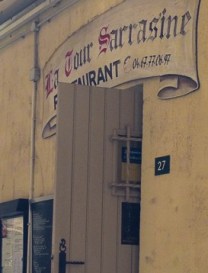Sunday Lunch and the Olive Festival
East of Capestang, the Canal du Midi makes a big loop, swinging by the sweet village of Poilhes, maybe five kilometers away. My research had uncovered two or three highly recommended restaurants there, so I pointed my trusty Citroën in that direction for Sunday lunch.
At the bend in the Canal, I was pleasantly surprised to spot La Tour Sarrasine, which was supposed to be closed on Sundays, but was very much open for business. I got a good table overlooking the Canal, and just as the garçon brought my lunch I held my breath with the other diners as two rental boats came within a hair’s breadth of T-boning right in front of us. It was obvious from the aftermath that one of the “captains” was clueless. I wasn’t quick enough to get a good shot of the drama, however.
I can almost never turn down mussels, and these were exquisite: smaller than the length of my knuckle to the first joint on my forefinger, some tinier, glistening with the butter, olive oil and garlic in which they were bathed. The garlic was clearly evident by aroma and taste, but it was so finely minced as to be nearly indistinguishable to the eye. The meat was sweet, tender, and utterly fantastic.
Dessert was a molten chocolate cake, warm in the center, with rich vanilla ice cream on the side and a persimmon garnish. And the wine, a quarter-bottle of crisp white Corbières, was kept chilled in this nifty ice bag. Quelle bonne idée!
A stroll around the village, and I was ready to press on.
In Bize-Minervois there’s an olive farm and oil factory called L’Oulibo, which I discovered during my brief visit in March. They were putting on a festival celebrating the new harvest of their Lucques olives. This variety, grown almost exclusively in the Languedoc-Roussillon, have become my favorite green olives (there’s a black type as well). They’re crisp, sweet and meaty and not overly briny like most of those you find in the US. They were offering olive-cracking lessons: using the flat end of a piece of olive wood, you whacked the olive gently, just to crack the skin a bit without breaking the pit. When your little bucket was full, the guide filled it to overflowing with water, then you’d press the lid on securely. Instructions were to let the olives sit for ten days, changing the water daily. To make the brine, you put thyme branches, bay leaves and fennel (with fronds) in a pot and boil gently for five minutes, then add salt (from the little bag he provided) and let it cool. Add the drained olives and let them rest in the brine for 2-3 weeks before eating.
Making artisan olive oil still sometimes follows a method similar to the one used in ancient times, employing enormous granite millstones to grind the fruit and stones into pulp. The pulp is then spread on round hemp mats, stacked into a hydraulic press and squeezed till the oil is extracted. Large-scale producers obviously use more modern equipment, like picking machines and centrifuges, but there’s a certain romance about the old ways.
Bien manger, c’est atteindre le ciel — Chinese proverb
(Eating well is reaching heaven)









The mere mention of mussels makes me drool with envy. Thanks for the pic of the Citroen.
Mussels and olives! My favorites!